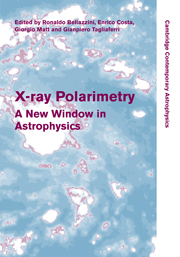Book contents
- Frontmatter
- Contents
- List of contributors
- Preface
- 1 X-ray polarimetry: historical remarks and other considerations
- Part I Polarimetry techniques
- 2 Scattering polarimetry in high-energy astronomy
- 3 Photoelectric polarimeters
- 4 Bragg crystal polarimeters
- 5 X-ray polarimetry with the photon-counting pixel detector Timepix
- 6 High-energy polarized photon interactions with matter: simulations with Geant4
- 7 The GPD as a polarimeter: theory and facts
- 8 Ideal gas electron multipliers (GEMs) for X-ray polarimeters
- 9 Broad-band soft X-ray polarimetry
- 10 Feasibility of X-ray photoelectric polarimeters with large field of view
- 11 Angular resolution of a photoelectric polarimeter
- 12 Development of a Thomson X-ray polarimeter
- 13 Hard X-ray / soft gamma-ray polarimetry using a Laue lens
- Part II Polarized emission in X-ray sources
- Part III Future missions
- Author index
- Subject index
4 - Bragg crystal polarimeters
from Part I - Polarimetry techniques
Published online by Cambridge University Press: 06 July 2010
- Frontmatter
- Contents
- List of contributors
- Preface
- 1 X-ray polarimetry: historical remarks and other considerations
- Part I Polarimetry techniques
- 2 Scattering polarimetry in high-energy astronomy
- 3 Photoelectric polarimeters
- 4 Bragg crystal polarimeters
- 5 X-ray polarimetry with the photon-counting pixel detector Timepix
- 6 High-energy polarized photon interactions with matter: simulations with Geant4
- 7 The GPD as a polarimeter: theory and facts
- 8 Ideal gas electron multipliers (GEMs) for X-ray polarimeters
- 9 Broad-band soft X-ray polarimetry
- 10 Feasibility of X-ray photoelectric polarimeters with large field of view
- 11 Angular resolution of a photoelectric polarimeter
- 12 Development of a Thomson X-ray polarimeter
- 13 Hard X-ray / soft gamma-ray polarimetry using a Laue lens
- Part II Polarized emission in X-ray sources
- Part III Future missions
- Author index
- Subject index
Summary
The most successful measurements of cosmic X-ray polarization have been made with Bragg crystal polarimeters. We review the fundamental techniques of Bragg crystal polarimetry, describe how these were implemented on the OSO-8 spacecraft and the SXRP polarimeteter intended for flight aboard the Spectrum-X-Gamma mission, and now, 35 years later, present an optimized design for a small satellite dedicated to polarimetric observations.
Introduction
A photon carries information about its direction, time of arrival, energy and polarization. Satellite missions such as Uhuru, Ariel V, HEAO-1 and ROSAT located hundreds of sources in their all-sky surveys, and missions such as HEAO-1, ASCA, Suzaku, RXTE, Chandra, and XMM/Newton characterized source spectra and time variability. The X-ray community now needs polarization information to reveal the intrinsic small-scale geometry of astrophysical systems and to evaluate physical processes in regions near compact objects which cannot be resolved via imaging, spectroscopy or timing.
X-ray radiation is polarized when the production mechanism has an implicit directionality, such as when electrons interact with a magnetic field to produce cyclotron and synchrotron emission. In radio quasars, for example, the amplitude of the polarization is a diagnostic for the X-ray emission mechanism and the polarization direction associates the X-ray emission with particular regions identified in milli-arc-second radio images. Polarization also occurs when X-rays are scattered by electrons, a common process in the highly ionized environments of compact X-ray sources.
- Type
- Chapter
- Information
- X-ray PolarimetryA New Window in Astrophysics, pp. 34 - 41Publisher: Cambridge University PressPrint publication year: 2010

